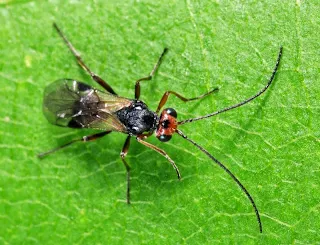 |
| Dinocampus coccinellae |
Here's a pretty little insect from the wasp family. Like a lot of members of this family, it is a parasitoid species, the females of which lay their eggs in the living bodies of other creatures, often other insects. This particular one, Dinocampus coccinellae, lays its eggs in ladybirds.
For several weeks an infected ladybird will carry on hunting aphids as though nothing much is happening and oblivious of the maggot growing inside it and eating its internal organs, apart from those essential to the ladybird, obviously. The ladybird needs to be kept alive to feed the growing wasp larva but unlike many related species of parasitoid wasp, it doesn't kill its host when it emerges from its body because it needs it for one more thing. It uses it as a living shield, making use of the ladybirds warning colouration to deter would-be bird and animal predators, and the ladybirds twitching reflex to deter ants, etc.
 |
| D. coccinellae emerging from body of ladybird. |
The mystery was just how this conversion to an automaton was precisely timed to coincide with the wasp larva emerging from its body.
Now a team led by parasitologist Nolwenn Dheilly, of the University of Perpignan in France have discovered the answer. As well as an egg, the adult wasp injects the ladybird with a virus which it had been storing in its oviduct and which multiplies rapidly and infects the ladybird's brain, but appears not to do it any harm - yet. Meanwhile, the developing larva produces a chemical which suppresses the ladybird's immune system. This virus is new to science.
Many parasites modify their host behaviour to improve their own transmission and survival, but the proximate mechanisms remain poorly understood. An original model consists of the parasitoid Dinocampus coccinellae and its coccinellid host, Coleomegilla maculata; during the behaviour manipulation, the parasitoid is not in contact with its host anymore. We report herein the discovery and characterization of a new RNA virus of the parasitoid (D. coccinellae paralysis virus, DcPV). Using a combination of RT-qPCR and transmission electron microscopy, we demonstrate that DcPV is stored in the oviduct of parasitoid females, replicates in parasitoid larvae and is transmitted to the host during larval development. Next, DcPV replication in the host's nervous tissue induces a severe neuropathy and antiviral immune response that correlate with the paralytic symptoms characterizing the behaviour manipulation. Remarkably, virus clearance correlates with recovery of normal coccinellid behaviour. These results provide evidence that changes in ladybeetle behaviour most likely result from DcPV replication in the cerebral ganglia rather than by manipulation by the parasitoid. This offers stimulating prospects for research on parasitic manipulation by suggesting for the first time that behaviour manipulation could be symbiont-mediated.
 |
| Zombie standing guard over the thing that's just eaten its internal organs. |
Now, here is an example of an evolutionary process which can't possibly be seen as either the work of a benevolent, caring, kind, designer or something designed to serve the needs of humans. Ladybirds are the major predator on aphids which do enormous economic damage to crops as well as spreading plant viruses so why would an anthropophilic designer design something to harm a potential ally against aphids? Whatever designed this certainly hadn't go the welfare of humans in mind.
Does this designer have something against ladybirds, maybe? Did they commit some ancestral sin, and so have to be eternally punished with exquisitely nasty suffering?
The only things that gain in this are the virus and the parasitoid wasp which have formed a mutually beneficial alliance so that neither can reproduce without the other. Did the designer favour viruses or parasitoid wasps, or both, maybe? Does this designer favour parasites?
For its sheer malevolence, this takes some beating. Whatever intelligence that could design such a thing could never conceivably be called good, or benign, or worthy of praise and worship. It might be worthy of fear and loathing, repugnance even, but surely never of adoration. There are some close contenders, mind you - the beautiful little Ambulex compressa, another charming little wasp, for example.
As an evolved process, the product of an unemotional, amoral, mindless, undirected and unplanned evolutionary process, of course, it becomes easily understandable, even elegant, though no less exquisitely nasty and, scaled up a thousand-fold, the thing of nightmare.


No comments :
Post a Comment
Obscene, threatening or obnoxious messages, preaching, abuse and spam will be removed, as will anything by known Internet trolls and stalkers, by known sock-puppet accounts and anything not connected with the post,
A claim made without evidence can be dismissed without evidence. Remember: your opinion is not an established fact unless corroborated.